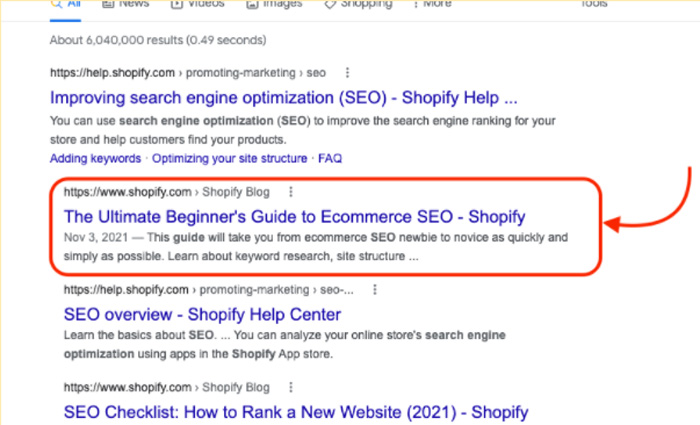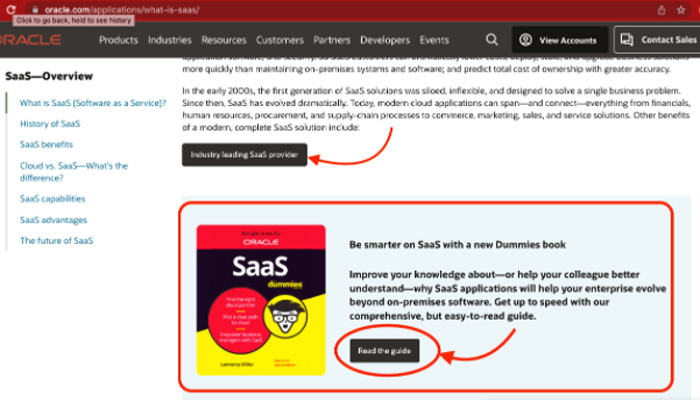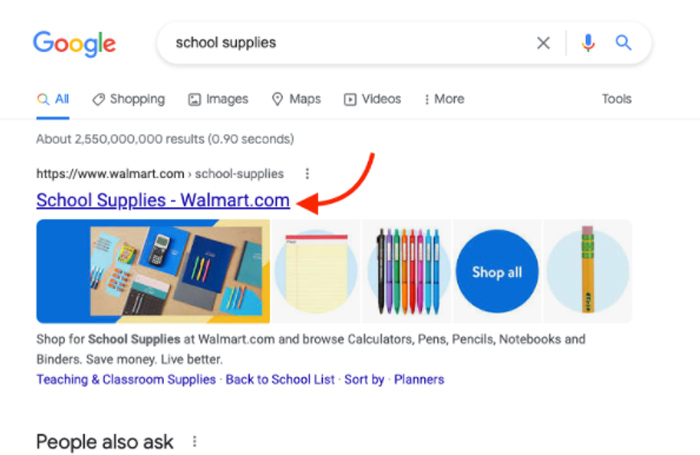We could turn blue in the face splitting hairs about the ideal word count for an article.
What works best between long form and short form content? It depends.
That’s the most infuriating answer, but it’s also true.
Whether or not long or short form content is beneficial for your eCommerce site depends on several factors, which we can loosely summarize as subject matter and search intent.
Today we’ll break down the pros and cons of each form of content and when it’s most beneficial to use each one.
Pros and Cons of Long Form Content
Long form content refers to any writing on your site that is between 1,000–7,500 words.
Examples include beginner guides, buyer guides, tutorials, case studies, and white papers. Video essays and podcasts also fall under long form content.
The focus of long form content is to provide in-depth information to the reader about your product or niche.
Shopify’s ultimate guide on eCommerce SEO is 3,500 words long! It’s packed with authoritative content and peppered with multimedia demonstrating their products.

Pros of Long Form Content
Long form content:
- Helps your site rank well on the first search engine results page (SERP). Search algorithms prioritize long form content partly because well-written, in-depth content fulfills Google’s page quality ranking criteria—beneficial purpose and E-A-T (Expertise, Authoritativeness, and Trustworthiness).
- Enables you to rank for multiple keywords without risking penalties for keyword stuffing. The word count gives plenty of buffer room to explore other keywords related to your product.
- Increases page performance by earning more backlinks for your site. The more valuable and comprehensive your pages are, the more websites will link back to your site.
- Builds brand equity and establishes your brand as a market leader in your niche.
- Has higher conversion rates because the type of customer who would read a detailed piece shows commitment to their purchase with the right information.
The benefits of long form content for eCommerce are manifold, but let’s focus on two key advantages.
By helping your page to rank well on SERPs, long form content gives your eCommerce business easy access to the 36% of customers who start their buying process on search engines.
Grilla Grills is a great example of this—their 2,300-word how-to guide ranks 8th on the first search result page for the search term ‘how to plan a barbecue party’.

The second advantage is the brand equity that years of long form content gives you. While short form content provides brief bursts of sales growth, long-term brand building gives you years of steady sales growth.
Oracle, an industry leader in SaaS (Software as a Service), ranks on the first page with their detailed, evergreen, 1,800-word article on ‘what is SaaS?’.

The same article forms the basis on which they generate leads and upsell their SaaS products.

Binet & Field illustrate the need to focus on top-of-the-funnel strategies which build brand awareness as they eventually lead to higher sales.

- Long form content requires more time and resources to create. However, you can easily solve this by outsourcing your writing to a reputable copywriting service.
- Today’s information-saturated audience may struggle with sustaining attention throughout a long article. However, this is a highly subjective con that is easily resolved by an engaging introduction and a well-structured, high-quality article.
Overall:
Long form content increases your site performance and helps your business rank well on search engine results, while also forming the backbone of your content marketing strategy and creating brand equity.
The fact that it takes considerable time and resources to produce is easy to solve with the right content partners by your side.
If you need well-written, quality long form articles at scale, get in touch with CopySmiths today.
It has been a pleasure working with the CopySmiths team – they are reliable, efficient, and great at curating high-quality content on complex subjects. — Sander Tamm, e-student.org
Pros and Cons of Short Form Content
Short form content is a staple of the internet as we consume it today.
From brief product descriptions and video shorts to 280-character tweets, both B2B and B2C eCommerce businesses are focusing primarily on short form content.
Pros of Short Form Content
Short form content:
- Grabs readers’ attention quickly and effectively since it typically focuses on a single idea or product value.
- Is easier to consume and more mobile-friendly—social media networks and website designs today prioritize mobile users, who generate over 50% of global internet traffic.
- Requires fewer resources and can often be batch-created based on existing templates.
Cons of Short Form Content
These are great pros, but short form content can also:
- Lack in-depth coverage of topics, which may fail to satisfy a customer who has an informational search query and is looking to know more about your product.
- Expire quickly as it typically relies on hot topics and current trends to grab the attention of the reader.
- Become mechanical and lack originality, similar to the TikTok trends, hashtags and trending topics that become so ubiquitous online they lose the “wow” factor for the reader.
Overall:
Short form content is ideal for specific product activations that have a shelf life, such as holiday sales or limited editions. It also works for certain content marketing aims, like customer loyalty offerings.
Walmart ranks first for the keyword ‘school supplies’ with their concise product catalog.

However, short form content can’t make up the entire content on your eCommerce site. It builds on the backbone of evergreen, long form content.
How to Choose Between Long Form and Short Form Content
With a clearer idea of the benefits of both long and short form content, how do you determine when to use each form?
1 – Determine Your Content Marketing Goals
Different stages of your content marketing strategy will demand specific forms of content and publishing channels.
In the table below, we compare the recommended and most effective content formats for each marketing objective.
| Content Marketing Objective | Long Form Content | Short Form Content |
| Long-term lead generation |
| ╳ |
| New customer revenue generation |
| ╳ |
| Grow and nurture email list |
|
|
| Improve customer retention | ╳ |
|
| Build customer loyalty | ╳ |
|
| Build interest groups for retargeting | ╳ |
|
| Share results and experience |
| ╳ |
2 – Figure Out Your Audience Search Intent
Getting search intent right means that your content satisfies your audience. Consumers will stay on your site longer and eventually purchase your product.
The last thing you want to do is only offer a short article when your customer is looking for an in-depth product guide or how-to.
Search intent is the purpose behind a user’s online search and is a crucial part of keyword research.
To find out the search intent of the keywords you’re targeting, you can:
- Check the search results pages for the type of results that come up.
- Create a non-intrusive, short pop-up survey on your site about audience search intent.
How does search intent influence the content format you choose?
In this table, we look at the four types of user intent and the type of content that best satisfies them.
| Type of Search Intent | User Action | Recommended Content Format |
| Informational intent | Looking for product information | Long Form—detailed blog post |
| Navigational intent | Looking for your website | Short Form—landing page |
| Transactional intent | Wants to buy a specific product | Short Form—product description page |
| Commercial intent | Researching multiple product options to buy later | Long Form—product reviews and comparisons |
3 – Benchmark Your Content Against Competitors
Your eCommerce business doesn’t exist in a vacuum. Remember that your competitors are also jockeying for one of the 10 spots in the first search results page.
Benchmarking your competitors’ content for specific keywords helps you figure out the best content format for you.
For each keyword you wish to target in your content, check:
- Which pages are currently ranking for the specific keyword?
- What’s the average text length of the top ranking pages?
Content marketing analytics tools like Semrush can give you more detailed benchmarking criteria, such as recommended backlinks, related keywords, and readability of your competitors’ content.
4 – Key Conversion Touchpoints in Your Business Model
Quality touchpoints significantly influence your customer’s choices regarding your product and brand as a whole.
A consumer goods brand selling bath products on the B2C end may get a sale from a few good digital ads. On the other hand, a B2B eCommerce store selling manufacturing machinery would need 50 or more touchpoints spanning a drawn-out purchasing period.
Longer and more complex sales conversion requires long form content pieces to create awareness and educate the consumer. Short form content works best with quicker, time-bound conversions.
Ultimately, your eCommerce business will benefit from incorporating both long and short form content in the various stages of the buyer’s journey.
Frequently Asked Questions
What is the best content length for SEO?
According to HubSpot, long form content ranging between 2,100–2,400 words is the sweet spot for well-ranking articles. Remember that Google is looking for articles with expertise, facts, evidence, and authority.
How often should you blog for SEO?
Blog content is necessary to rank organically on search pages without advertising. Experts recommend 3–4 times a week for small businesses and daily for large organizations in order to build traffic. Brand awareness posts can be posted less frequently since they are evergreen.
Can short articles rank?
Yes, they can. Although Google’s Search Quality Rating Guidelines favor longer articles, a short blog article may still rank if you have optimized it for the target keywords and it answers the user intent.
Do What Works for Your Business
Your choice of content form depends on your marketing goals, conversion touch points, competitors, and user intent.
That said, long form content seems to come out ahead both as the backbone of a solid content marketing strategy and the preferred choice of search algorithms.
Short form content may not perform as well as its counterpart in SEO and brand building. However, it has its place when the search intent is transactional and supplements your longer pillar articles.
Are you wondering how to get started on your long form content? Reach out to CopySmiths to get a single trial article or a batch of quality articles.
Share on LinkedIn:

